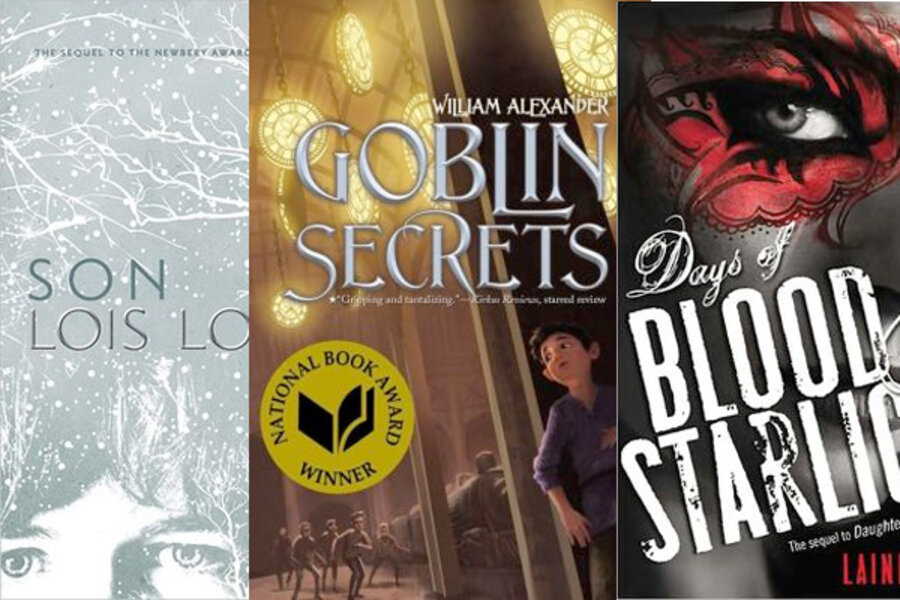3 YA books just perfect for adults
Loading...
Before Katniss Everdeen ever picked up her bow, a young boy named Jonas saved a baby in Lois Lowry’s Newbery winner “The Giver.”
Written in 1993, “The Giver” was the novel that moved dystopias from the adult to young adult shelves. When Lowry pitted a 12-year-old boy against a totalitarian government that wanted to kill off everything “difficult” (from colors to emotions to a baby named Gabriel who wouldn’t sleep through the night), it marked a shift in teen literature.
Then on the heels of this came another literary revolution. Thanks to the overwhelming popularity of J.K. Rowling’s “Harry Potter” series, Stephenie Meyer’s “Twilight” series, and Suzanne Collins’s “The Hunger Games” trilogy, books originally aimed at teens are now drawing readers of all ages.
When Lowry returned to the futuristic city in “The Giver” this year to tell the story of Gabriel’s teenage mother, Claire, she did so in a literary landscape in which hordes of teens are valiantly flinging themselves against corrupt governments of every stripe. Three new YA novels including Lowry’s Son – all of which are likely to be equally popular with adult readers – show young people searching for lost loved ones amid corrupt and crumbling societies.
“Son,” which is written in three parts, is the finale of a quartet that also includes “Gathering Blue” and “Messenger.” The first and strongest section retells the events of “The Giver” from the viewpoint of Claire, who was 12 when she was “assigned” the position of birth mother. She must produce three babies, which will be handed over to families by the Council of Elders. (Lowry is very skillful at avoiding descriptions that are too detailed for her audience, but the horror of Claire’s situation is clear.)
Something goes wrong during the birth, and, for some reason, Claire isn’t put back on the numbing pills everyone over the age of 12 takes daily. Desperate to find her baby, she sneaks visits to the Nurturing Center and then makes a desperate escape to follow her son.
The second section of the novel shifts from the black-and-white, sterile world of the city to a fishing village, complete with color and birds, that takes in Claire after she washes ashore. While it loses the momentum built up in the first section, the second has its own pleasures. But then the third and weakest section sidelines Claire to reunite readers with Jonas, Gabe, and other characters from earlier novels for a metaphysical standoff against personified evil from “The Messenger.”
Ultimately, “Son” is not equal to “The Giver” – but then, few YA books are.
Music hasn’t been outlawed in Goblin Secrets, William Alexander’s first novel – which came out of nowhere to win the National Book Award in November – but acting is absolutely forbidden in Zombay.
Rownie’s older brother, Rowan, defied the ban and disappeared months earlier with the Guard in hot pursuit, leaving Rownie to the not-so-tender mercies of Graba, a Baba Yaga-like figure who collects “grandchildren” to run errands for her. While off to fetch oil for Graba’s clockwork bird legs, Rownie stumbles on a goblin troupe performing a play, complete with masks and puppets, and runs off to join the troupe.
As Rownie discovers, acting has a magic of its own. By playing a hero, he becomes one.
The ending comes too quickly for all the emotions Alexander has set in play to fully breathe, and several questions are left unanswered. But Alexander has created a satisfying fantasy world that stage-struck tweens (and their parents) will love to visit.
Grown-ups out there who belong to YA book clubs, if you haven’t added Laini Taylor’s “Daughter of Smoke & Bone” trilogy to your list, scribble it in at the top. Taylor’s 2011 novel, aimed at teens ages 14 and up, is one of the most gripping and memorable starts to a series I’ve read in a long time.
Set in Prague, it follows Karou, a blue-haired art student who has a double life running errands for a group of monsters as their self-described “hither and thither girl.”
The monsters, called the chimaera, might have rams’ horns or snake bodies, but that doesn’t necessarily make them evil, any more than a pair of wings makes an angel divine. Both sides have been locked in a war for decades, with the angels trying to reconquer their former slaves.
The first book ended with Karou discovering that everything she loved is gone, courtesy of the angel she loves.
As she puts it, “You know how, at the end of ‘Romeo and Juliet,’ Juliet wakes up in the crypt and Romeo’s already dead?... Well, imagine if she woke up and he was still alive, but ... he had killed her whole family. And burned her city. And killed and enslaved her people.”
The sequel, Days of Blood & Starlight, opens with her human friends, Zuzana and Mik, as well as Akiva, the angel who loved her and wrecked everything, desperate to find her. Karou, meanwhile, is trying to undo the evil done to her people.
As is often the case with second books in trilogies, “Days of Blood & Starlight” is less tightly constructed and a little less satisfying. But the series as a whole is gripping enough to choke out everything else – chores, meals, bathroom breaks – while you read. Plus, there’s still that army of angels to defeat.
Yvonne Zipp is the Monitor’s fiction critic.






